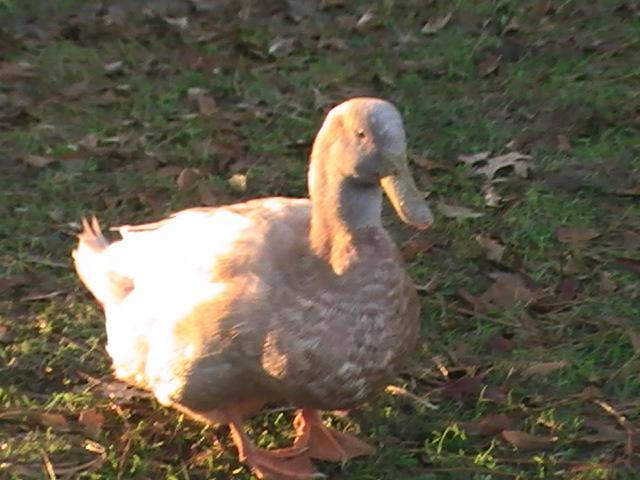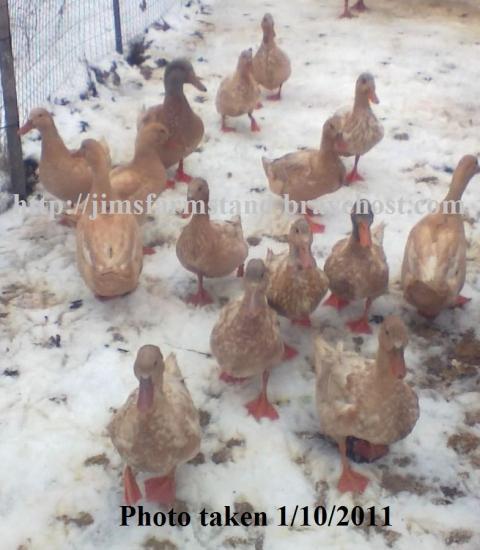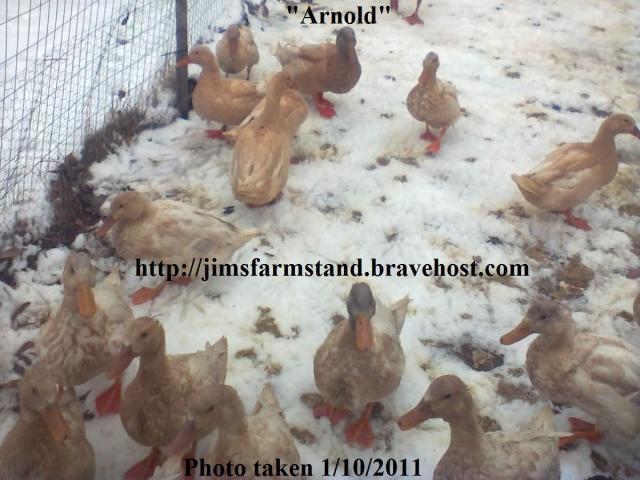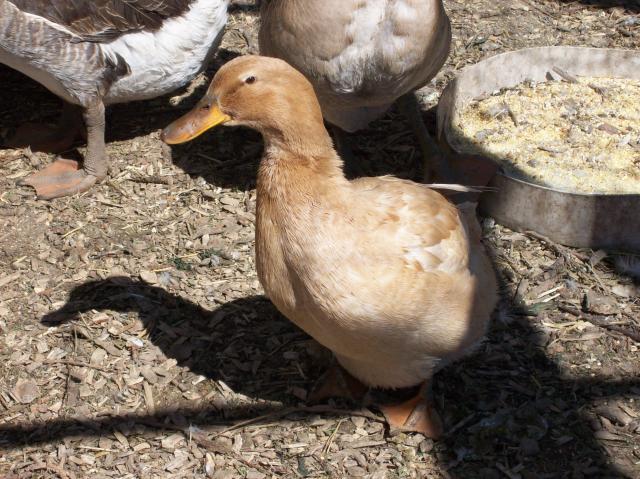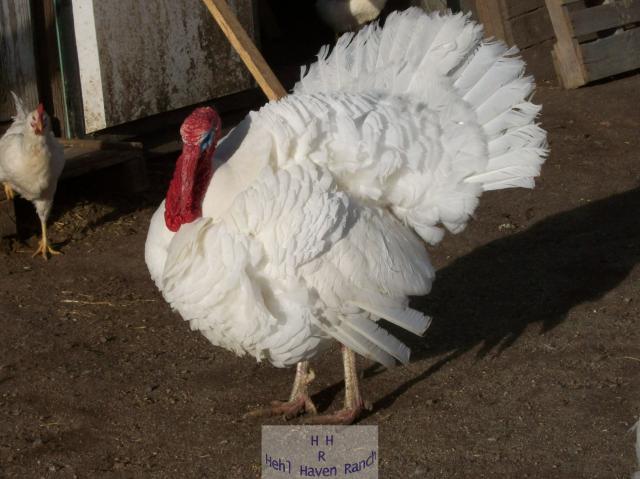This is like the Online Crazy Egg Chain, and the SQ Egg Swap, but with a Heritage twist!
It is for those wanting to raise birds that are shown, can be shown, or have the quality to be shown in an American Poultry Association sanctioned poultry show.
HOWEVER, ALL OFFERS MUST BE ON THE ALBC Conservation Priority List (See below)
You don't have to show to play, but you have to raise stock that can be shown or produce offspring that can be shown and are Heritage per the ALBC.

SWAP RULES - This list is subject to change so please check back periodically.
All people must be 18 or older to play.
EGGS should be from show quality stock or atleast breeder quality that could produce show qualty stock. All breeds of poultry are welcome.
Eggs CAN NOT be from mixed colors unless standards allow colors to be mixed
You are required to offer at least 6 eggs. (Four eggs for Turkey and Goose).
You are more than welcome to offer eggs from different breeds but the total of eggs must be 6 of the first offer. You are more than welcome to offer more eggs.
(Note: A second or third breed of non-heritage, but show quality can be offered of 4 to 6 plus eggs. But first breed must be a heritage show quality and 6 eggs)
When you accept eggs, you must post your offer. Pictures are recommended.
When each trade is posted, please pm or email the person who offered the eggs and work out the shipping arrangements.
The person sending the eggs pays the shipping costs.
When eggs are mailed, swapper needs to send a courtesy email to the swappee to let them know that the eggs are on their way.
Please offer eggs that you will have available to ship within two weeks of offering. Please send eggs no older the 4 days when shipped.
If the thread stalls for 6 hours, try changing your offer if you can.
If combining different breeds, write in pencil on the eggs with the breed.
Side trades are welcome but please use PMs to avoid confusion.
If a person does not ship their eggs within one weeks of accepting offer unless other wise stated in offer you will not be able to play until all of your eggs are shipped.
If a person does not ship their eggs, they will be banned from this swap. We will not allow people to get eggs from others and not ship out the eggs they say they would ship.
DISCLAMER: BYC IS NOT RESPONSIBLE FOR THIS SWAP. BYC is not responsible for egg sent, received or not received. Please do not pm the mod about your eggs. PM me. If you do not receive your egg I can not make them send them but will make sure they do not play anymore. Please remember since theses are shipping eggs, they do not have guarantee on hatch rate due to shipping and/or incubation methods.
It is for those wanting to raise birds that are shown, can be shown, or have the quality to be shown in an American Poultry Association sanctioned poultry show.
HOWEVER, ALL OFFERS MUST BE ON THE ALBC Conservation Priority List (See below)
You don't have to show to play, but you have to raise stock that can be shown or produce offspring that can be shown and are Heritage per the ALBC.

SWAP RULES - This list is subject to change so please check back periodically.
All people must be 18 or older to play.
EGGS should be from show quality stock or atleast breeder quality that could produce show qualty stock. All breeds of poultry are welcome.
Eggs CAN NOT be from mixed colors unless standards allow colors to be mixed
You are required to offer at least 6 eggs. (Four eggs for Turkey and Goose).
You are more than welcome to offer eggs from different breeds but the total of eggs must be 6 of the first offer. You are more than welcome to offer more eggs.
(Note: A second or third breed of non-heritage, but show quality can be offered of 4 to 6 plus eggs. But first breed must be a heritage show quality and 6 eggs)
When you accept eggs, you must post your offer. Pictures are recommended.
When each trade is posted, please pm or email the person who offered the eggs and work out the shipping arrangements.
The person sending the eggs pays the shipping costs.
When eggs are mailed, swapper needs to send a courtesy email to the swappee to let them know that the eggs are on their way.
Please offer eggs that you will have available to ship within two weeks of offering. Please send eggs no older the 4 days when shipped.
If the thread stalls for 6 hours, try changing your offer if you can.
If combining different breeds, write in pencil on the eggs with the breed.
Side trades are welcome but please use PMs to avoid confusion.
If a person does not ship their eggs within one weeks of accepting offer unless other wise stated in offer you will not be able to play until all of your eggs are shipped.
If a person does not ship their eggs, they will be banned from this swap. We will not allow people to get eggs from others and not ship out the eggs they say they would ship.
DISCLAMER: BYC IS NOT RESPONSIBLE FOR THIS SWAP. BYC is not responsible for egg sent, received or not received. Please do not pm the mod about your eggs. PM me. If you do not receive your egg I can not make them send them but will make sure they do not play anymore. Please remember since theses are shipping eggs, they do not have guarantee on hatch rate due to shipping and/or incubation methods.
ALBC Conservation Priority Poultry Breeds 2011
http://www.albc-usa.org/documents/CPLPoultry2011.pdf
Critical: Fewer than 500 breeding birds in the United States, with five or fewer primary breeding flocks (50 birds or more), and
estimated global population less than 1,000.
Threatened: Fewer than 1,000 breeding birds in the United States, with seven or fewer primary breeding flocks, and estimated
global population less than 5,000.
Watch: Fewer than 5,000 breeding birds in the United States, with ten or fewer primary breeding flocks, and estimated global
population less than 10,000. Also included are breeds that present genetic or numerical concerns or have a limited geographic
distribution.
Recovering: Breeds that were once listed in another category and have exceeded Watch category numbers but are still in
need of monitoring.
Study: Breeds that are of genetic interest but either lack definition or lack genetic or historical documentation.
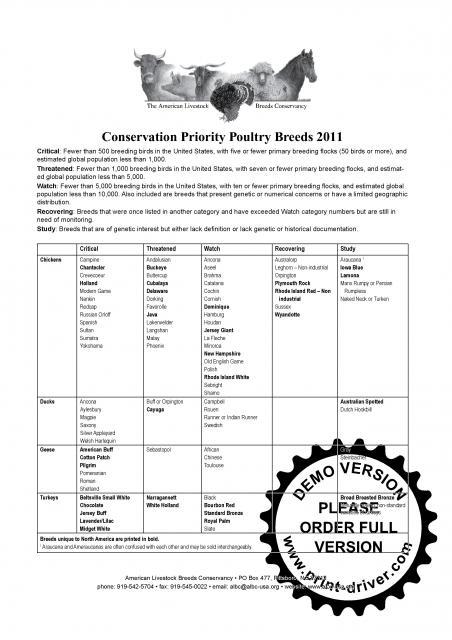
Quote:
ALBC Duck list:
http://www.albc-usa.org/documents/CPLPoultry2011.pdf
Critical: Fewer than 500 breeding birds in the United States, with five or fewer primary breeding flocks (50 birds or more), and
estimated global population less than 1,000.
Threatened: Fewer than 1,000 breeding birds in the United States, with seven or fewer primary breeding flocks, and estimated
global population less than 5,000.
Watch: Fewer than 5,000 breeding birds in the United States, with ten or fewer primary breeding flocks, and estimated global
population less than 10,000. Also included are breeds that present genetic or numerical concerns or have a limited geographic
distribution.
Recovering: Breeds that were once listed in another category and have exceeded Watch category numbers but are still in
need of monitoring.
Study: Breeds that are of genetic interest but either lack definition or lack genetic or historical documentation.

Quote:
ALBC Duck list:
Critical
Ancona
Aylesbury
Magpie
Saxony
Silver Appleyard
Welsh Harlequin
Threatened
Buff or Orpington
Cayuga
Watch
Campbell
Rouen
Runner or Indian Runner
Swedish
Study
Australian Spotted
Dutch Hookbill
ALBC Goose list:
Ancona
Aylesbury
Magpie
Saxony
Silver Appleyard
Welsh Harlequin
Threatened
Buff or Orpington
Cayuga
Watch
Campbell
Rouen
Runner or Indian Runner
Swedish
Study
Australian Spotted
Dutch Hookbill
ALBC Goose list:
Critical
American Buff
Cotton Patch
Pilgrim
Pomeranian
Roman
Shetland
Threatened
Sebastopol
Watch
African
Chinese
Toulouse
Study
Gray
Steinbacher
ALBC Turkey list
American Buff
Cotton Patch
Pilgrim
Pomeranian
Roman
Shetland
Threatened
Sebastopol
Watch
African
Chinese
Toulouse
Study
Gray
Steinbacher
ALBC Turkey list
Critical
Beltsville Small White
Chocolate
Jersey Buff
Lavender/Lilac
Midget White
Threatened
Narragansett
White Holland
Watch
Black
Bourbon Red
Standard Bronze
Royal Palm
Slate
Study
Broad Breasted Bronze
Naturally mating, non-standard
varieties of
turkeys
Beltsville Small White
Chocolate
Jersey Buff
Lavender/Lilac
Midget White
Threatened
Narragansett
White Holland
Watch
Black
Bourbon Red
Standard Bronze
Royal Palm
Slate
Study
Broad Breasted Bronze
Naturally mating, non-standard
varieties of
turkeys
Last edited:

